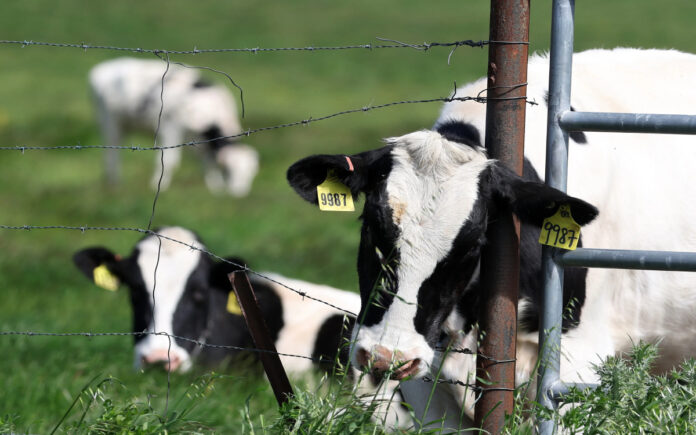Washington: The U.S. Department of Agriculture (USDA) eased an emergency order last spring aimed at curbing the spread of bird flu among dairy cattle following pushback from state officials and industry stakeholders, according to state and federal records obtained by the international news agency Reuters.
These communications reveal how early federal responses to the bird flu outbreak were influenced by industry interests hesitant to comply with stringent regulations, potentially facilitating the transmission of the virus across state lines.
In April, after bird flu cases were identified in dairy cows across eight states, the USDA implemented an order requiring milk-producing dairy cattle moving between states to obtain a negative bird flu test no more than seven days before transport. The order also permitted non-producing cattle destined for slaughter to cross state lines without a veterinarian’s clean bill of health.
Originally, the USDA considered more rigorous testing requirements, including a three-day window for testing, but opted for a more lenient approach based on industry feedback, according to documents included in the records request.
Experts expressed concern that relaxing these requirements may have contributed to the virus’s spread, citing logistical challenges in testing animals within a shorter timeframe. When the USDA issued the order on April 24, 33 herds had tested positive for bird flu. Since then, the outbreak has escalated, now affecting over 330 herds in 14 states and resulting in human cases among 17 dairy workers.
“Any changes or clarifications to the Federal Order have been made with the objective of protecting animal and public health by following scientific best practices, using the best available data, and ensuring the appropriate balance between compliance and feasibility for producers,” stated a USDA spokesperson in an email.
The USDA has conducted over 16,000 pre-movement tests and is currently investigating whether improper cattle movement contributed to the virus’s introduction in California, as confirmed by the spokesperson. The swift spread of bird flu among dairy herds, along with infections reported in 27 individuals this year, has raised alarms among public health experts, who argue that the USDA’s response has not been aggressive enough.
Memos and Meetings
On the morning of April 24, USDA chief veterinarian Rosemary Sifford held a meeting with the Livestock Marketing Association (LMA) to discuss the forthcoming federal order, as indicated in a memo from the industry group sent to USDA officials and released through a public records request.
“The 72-hour pre-movement time frame we have heard is being contemplated is simply not accomplishable,” wrote Chelsea Good, LMA’s vice president of government and industry affairs, suggesting a more feasible testing window of 7 to 14 days.
The farm agency did not specify a timeframe for testing in its initial order or in supplemental information released on April 25. However, a guidance document published on April 26 ultimately allowed dairies a seven-day testing window.
In an ideal situation, testing would ideally occur within 24 hours, according to Keith Poulsen, a veterinarian and director of the Wisconsin Veterinary Diagnostic Laboratory. He noted that the rural locations of dairy farms complicate the transport of samples to laboratories.
Also Read | Mother Blames AI Chatbot for Son’s Suicide in Groundbreaking Lawsuit Against Character.AI and Google
During that same week in April, state animal health officials advised the USDA to permit states to accept alternative documentation instead of a veterinary bill of health for non-lactating dairy cows moving to slaughter across state lines. Older dairy cattle are frequently processed into ground beef.
In the guidance issued on April 26, the USDA stated that states would be able to accept alternative documentation, which could include basic information such as the addresses of cattle owners and shippers.
Requiring veterinary documentation can be prohibitively expensive for dairies operating on narrow profit margins, according to Bob Seiler, president of the Central Equity Milk Cooperative in Kansas. He remarked that he has not been required to provide alternative documentation when sending non-lactating cows to slaughter.
By bypassing the veterinary sign-off, the risk of further virus spread could increase, cautioned Gail Hansen, a former state veterinarian in Kansas. “The chances of something slipping through the cracks is a lot bigger,” she noted.
A shortage of rural veterinarians may hinder farmers’ ability to secure herd inspections prior to every shipment, Poulsen added. The USDA spokesperson stated that cows moving to slaughter are viewed as lower risk for spreading bird flu and that alternative documentation facilitates traceability in the event of infections.
Also Read | U.S. Senator Lindsey Graham Sees Hope for Israel-Saudi Deal This Year
‘No Upside to Test’
California is investigating how the virus was introduced into the state, including whether the imported cows met legal requirements, according to the state agriculture department. Since the end of August, more than 130 herds and 13 dairy workers in the top dairy-producing state have contracted the virus.
Even prior to the federal order, the agricultural sector was relying on state officials to counter calls for restrictions on cattle movement, as revealed in the obtained records. In a March 26 email, Kansas Farm Bureau CEO Terry Holdren requested that Kansas Agriculture Secretary Mike Beam and the state’s animal health officer, Justin Smith, apply “any leverage or pressure” to ensure Nebraska continued accepting cattle, after learning that Nebraska might impose restrictions.
On April 1, Nebraska began requiring permits for female breeding dairy cows coming from other states.
In some instances, farmers have opted to avoid testing their cows altogether. “There’s been no upside to a dairy producer to report and test,” stated Rick Naerebout, CEO of the Idaho Dairymen’s Association.



